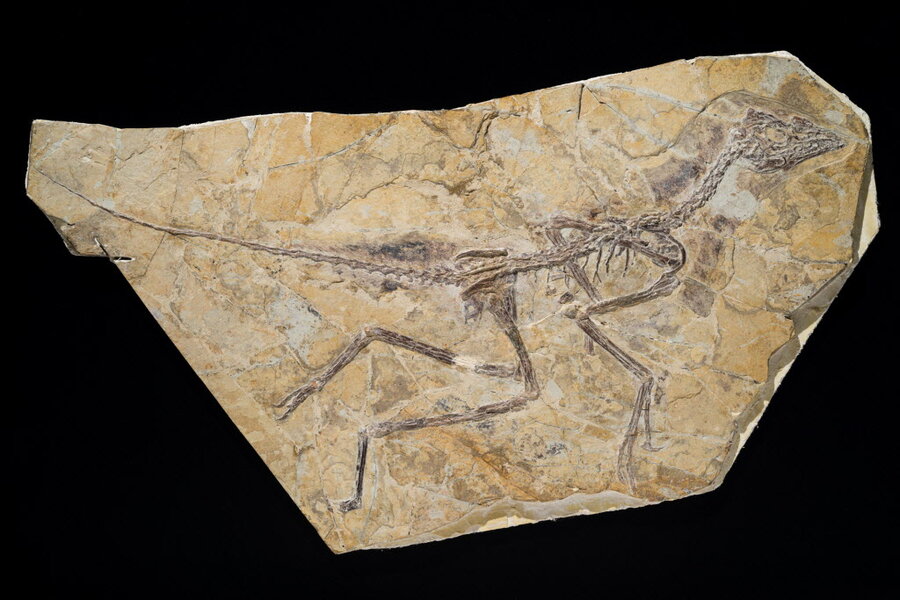Why the bird brain is actually a dinosaur brain
Loading...
It’s a well-known tenet of paleontology: Those dinosaur-shaped chicken nuggets are actually dinosaur-shaped dinosaurs. That is to say, birds are dinosaurs.
Not just descended from dinosaurs. Birds genuinely are dinosaurs, since modern biology classifies any organism as belonging to the group from which it descended.
But pinpointing the moment at which some dinosaurs evolved into birds, and identifying the unique features that actually distinguish between the two, has been a vexing problem in paleontology.
And it has just become more difficult. New research published in Nature suggests that one of the features once thought to be the exclusive domain of birds, the enlarged skull found in Archaeopteryx – often called the "first bird" – was in fact present in several other non-avian dinosaurs. That pushes back the evolution of the bird's complex, flight-supporting brain: non-avian dinosaurs, it seems, had similar brains and might have also been capable of flight.
In other words, the bird brain might just be a dinosaur brain.
“The flight-ready brain of Archaeopteryx does not represent a unique adaptation of birds for flight, but rather had evolved much earlier and was inherited by birds from their dinosaurian relatives,” says Gaberiel Bever, an assistant professor of anatomy at the New York Institute of Technology. “The large brain of birds predates birds themselves.”
The drama of bird evolution has for years turned on Archaeopteryx, an animal from the late Jurassic period some 150 million years ago. First discovered in 1861 in southern Germany, Archaeopteryx was initially considered a transitional fossil: its German name, Urvogel, means “first bird,” putting it squarely at that amorphous turning point when some dinosaurs became birds.
But over the last few years, the animal has been regularly un-pended from and then returned to its central evolutionary spot: Several studies have dismissed the animal from the avian tree altogether. Other studies have swept it back up into the tree again.
One data point in the debate has been Archaeopteryx’s brain. Birds are special among living reptiles for their enlarged brain case relative to their total body size. That disproportionate cranial size is critical to flight, which requires a complex nervous system. And Archaeopteryx’s brain, while a long way from the more evolved ones of modern birds, has long been known to be large enough to have supported flight.
But a team of scientists has now found that the Archaeopteryx’s flight-ready skull size is not unique among its relatives. CT scan data comparing Archaeopteryx’s brain size to those of about 20 living birds and 10 non-avian dinosaurs show that Archaeopteryx’s skull size is actually smaller than some of the closely related dinosaur skulls to which it was compared.
That means that an enlarged braincase, once considered a bird trademark, is not actually unique to birds: some non-avian dinosaurs also had big brain cases, a find similar to previous research showing that feathers and long hands pronged like a fork – once fingered as specifically avian attributes – were also present in non-avian dinosaurs, the authors said.
“It’s hard to say what a bird is, because all these characteristics we’ve traditionally associated with birds keep getting moved down and down the evolutionary tree,” said Amy Balanoff, a researcher at the American Museum of Natural History in New York.
Still, most evidence suggests that Archaeopteryx was anatomically capable of flight. In 2004, a team of scientists from the Natural History Museum in London reported in Nature that the animal’s neurological system was sophisticated enough to allow flight. And in 2011, scientists from German and American universities found that the animal’s wings were likely underpinned with a layer of strong, black feathers that could have born the animal aloft.
So if Archaeopteryx had the capacity to fly, and if other feathered dinosaurs had bigger brain cases than did Archaeopteryx, its possible that those dinosaurs also had the capacity to take flight – though whether or not those animals did in fact fly is still unknown, said Balanoff.
The research, published in Nature, does not address the question of whether or not Archaeopteryx was the first bird. Instead, it suggests that Archaeopteryx was one among several lookalike animals with flight-supporting brains.
“Archaeopteryx is in the evolutionary middle – but it’s not uniquely in the middle,” said Dr. Balanoff.
One of those animals would continue on to give us modern birds, and maybe that animal was Archaeopteryx. But pinpointing where exactly modern birds came from is now largely a matter of splitting evolutionary hairs, said Bhart-Anjan Bhullar, a postdoctoral researcher at Harvard University who was not involved in the research.
“This paper represents a fundamental evolutionary insight,” said Dr. Bhullar.
“What this essentially means is that there were a whole bunch of things running around that looked like Archaeopteryx,” he said. “It was an Archaeopteryx world.”






